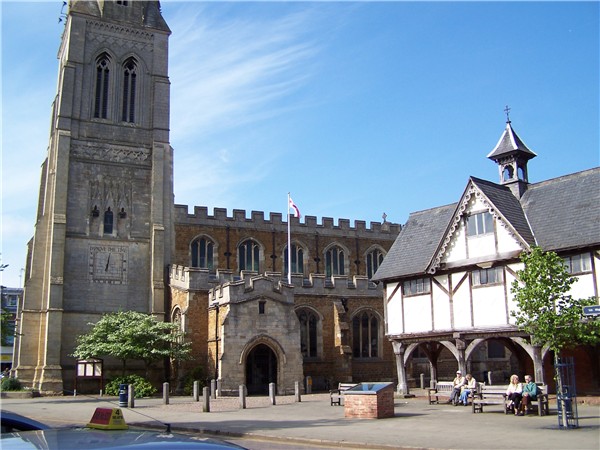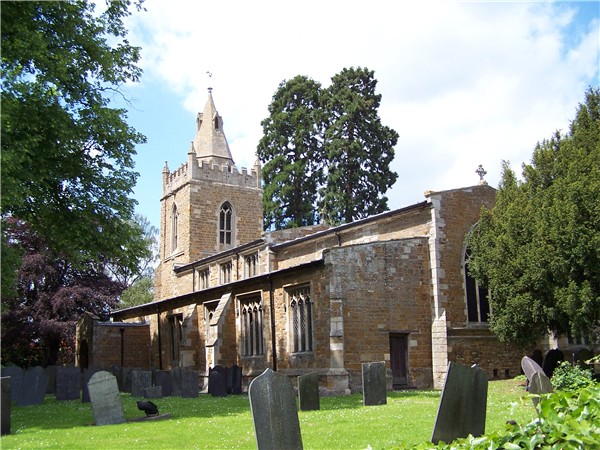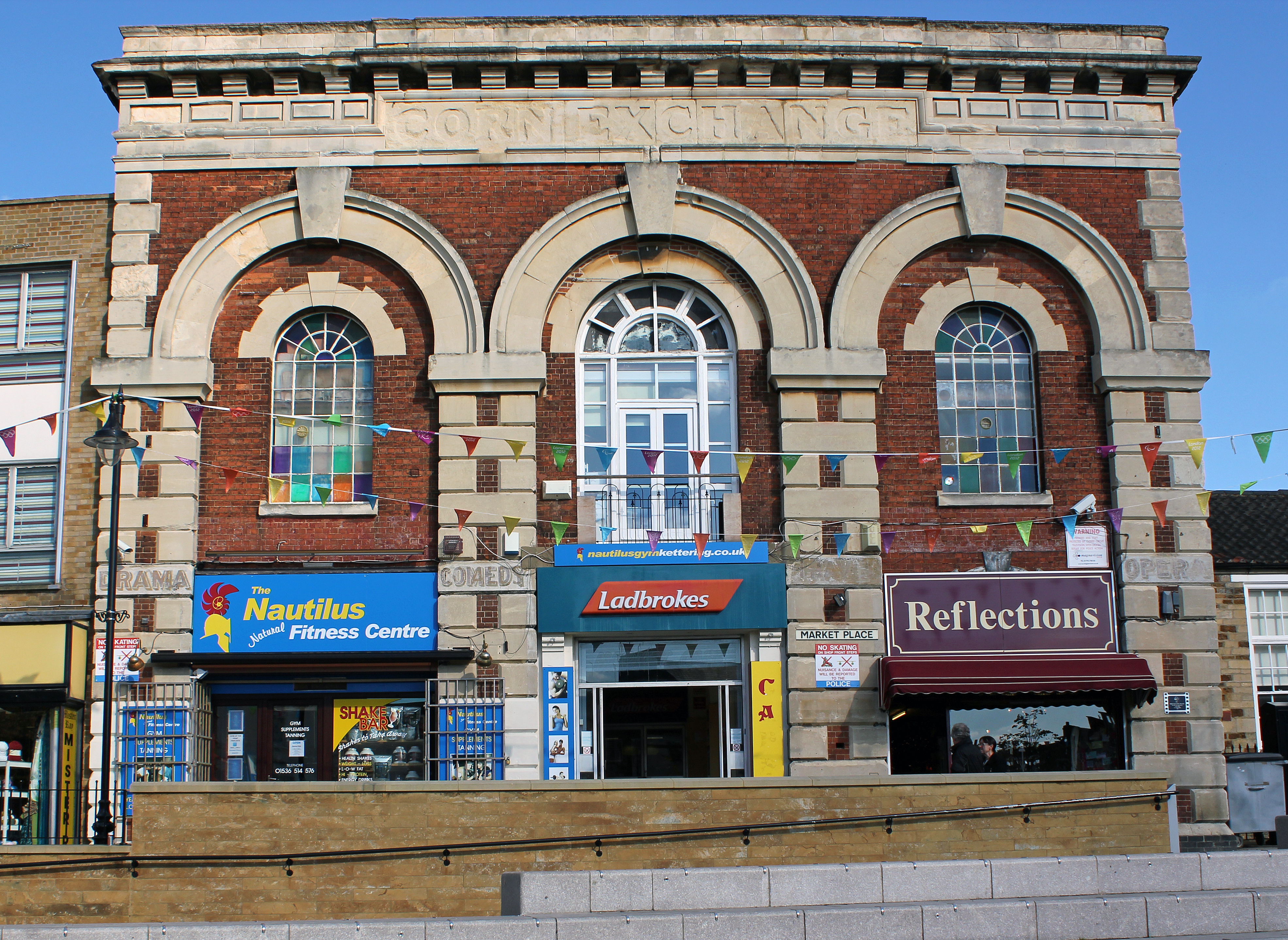|
Market Harborough
Market Harborough is a market town in the Harborough district of Leicestershire, England, in the far southeast of the county, forming part of the border with Northamptonshire. Market Harborough's population was 25,143 in 2020. It is the administrative headquarters of the larger Harborough District. The town was formerly at a crossroads for both road and rail; however, the A6 now bypasses the town to the east and the A14 which carries east-west traffic is to the south. Market Harborough railway station is served by East Midlands Railway services on the Midland Main Line with direct services north to Leicester, Nottingham, Derby and Sheffield and south to London St Pancras. Rail services to Rugby and Peterborough ended in 1966. Market Harborough was formerly part of Rockingham Forest, a royal hunting forest used by the medieval monarchs starting with William I, whose original boundaries stretched from Market Harborough through to Stamford and included Corby, Kettering, Desbo ... [...More Info...] [...Related Items...] OR: [Wikipedia] [Google] [Baidu] |
Harborough District
Harborough () is a local government district of Leicestershire, England, named after its main town, Market Harborough. Covering , the district is by far the largest of the eight district authorities in Leicestershire and covers almost a quarter of the county. The district also covers the town of Lutterworth and villages of Broughton Astley and Ullesthorpe. The district extends south and east from the Leicester Urban Area; on the east it adjoins the county of Rutland; has a boundary on the north with the boroughs of Charnwood and Melton; on the south it has a long boundary with the county of Northamptonshire comprising the districts of North Northamptonshire and West Northamptonshire. To the west the boundary is with Warwickshire and the borough of Rugby, a boundary formed for much of its length by the line of Watling Street. The north-western boundary of the district adjoins Blaby District and the borough of Oadby and Wigston. The villages of Thurnby, Bushby and Scraptoft abu ... [...More Info...] [...Related Items...] OR: [Wikipedia] [Google] [Baidu] |
Rugby Railway Station
Rugby railway station serves the town of Rugby in Warwickshire, England. It opened during the Victorian era, in 1885, replacing earlier stations situated a little further west. Since the closure of the former Rugby Central station, on the now-abandoned Great Central Railway route through the town, it is Rugby's only station. Between 1950 and 1970, the station was known as Rugby Midland before reverting to its original title. The station underwent an extensive remodelling between 2006 and 2008; new platforms were added and a new ticket office and entrance building were constructed. The original Victorian part of the station was retained in the upgrade. Rugby station is at the centre of two important junctions of the West Coast Main Line (WCML) connecting London to Birmingham, North West England and Scotland. The junction between the Trent Valley Line to the North West and the Rugby-Birmingham-Stafford Line to Birmingham is a short distance west of the station. East of the ... [...More Info...] [...Related Items...] OR: [Wikipedia] [Google] [Baidu] |
Broach Spire
A broach spire is a type of spire (tall pyramidal structure), which usually sits atop a tower or turret of a church. It starts on a square base and is carried up to a tapering octagonal spire by means of triangular faces. File:Leicester Cathedral panorama.jpg, Cathedral Church of Saint Martin, Leicester File:Broughton spire, Northants.JPG, Saint Andrew's Church, Broughton, Northamptonshire File:St John's, Weston.jpg, St John's Church, Weston, Runcorn, Cheshire, with its short broach spire File:Tower and broach spire of the Roman Catholic church of the Annunciation, New Mills, Derbyshire, January 2012.jpg, St Mary's Church, New Mills, Derbyshire File:Coddington Church - geograph.org.uk - 963136.jpg, All Saints, Coddington, Herefordshire Coddington is a hamlet and civil parish in eastern Herefordshire, England, about north of Ledbury.Ordnance Survey mapping The west side of the parish covers part of the Malvern Hills, an official Area of Outstanding Natural Beauty. Coddington s ... [...More Info...] [...Related Items...] OR: [Wikipedia] [Google] [Baidu] |
Domesday Book
Domesday Book () – the Middle English spelling of "Doomsday Book" – is a manuscript record of the "Great Survey" of much of England and parts of Wales completed in 1086 by order of King William I, known as William the Conqueror. The manuscript was originally known by the Latin name ''Liber de Wintonia'', meaning "Book of Winchester", where it was originally kept in the royal treasury. The '' Anglo-Saxon Chronicle'' states that in 1085 the king sent his agents to survey every shire in England, to list his holdings and dues owed to him. Written in Medieval Latin, it was highly abbreviated and included some vernacular native terms without Latin equivalents. The survey's main purpose was to record the annual value of every piece of landed property to its lord, and the resources in land, manpower, and livestock from which the value derived. The name "Domesday Book" came into use in the 12th century. Richard FitzNeal wrote in the ''Dialogus de Scaccario'' ( 1179) that the book ... [...More Info...] [...Related Items...] OR: [Wikipedia] [Google] [Baidu] |
Little Bowden
Little Bowden is an area on the edge of Market Harborough and former civil parish, now in the unparished area of Market Harborough, in the Harborough district, in the county of Leicestershire, England. As a village it was formerly part of Northamptonshire. The River Jordan runs through part of the area. Now, it's been integrated into Market Harborough and is fully part of the town using the town's address of 'Market Harborough'. In 1921 the parish had a population of 2768. On 1 April 1927 the parish was abolished and merged with Market Harborough. Amenities *Two pubs, The Cherry Tree and The Oat Hill (formerly The Greyhound) *The 13th-century Church of England parish church of Saint Nicholas, which is part of the Diocese of Leicester. *Little Bowden County Primary School A primary school (in Ireland, the United Kingdom, Australia, Trinidad and Tobago, Jamaica, and South Africa), junior school (in Australia), elementary school or grade school (in North America and the P ... [...More Info...] [...Related Items...] OR: [Wikipedia] [Google] [Baidu] |
Great Bowden
Great Bowden is a village and civil parish in the Harborough district of Leicestershire, England. It is north-east of and a suburb of Market Harborough, although originally the parish of Great Bowden included Harborough. The population is around 1,000, being measured at the 2011 census as 1,017. Places nearby include Market Harborough, Little Bowden, Sutton Bassett, Foxton and Thorpe Langton. Anglo-Saxon origins The village was included in the Domesday Book, under the name 'Bugedone' and was worth 40 shillings per year to the King. 'Bugedone', is a combination of the Old English female personal name 'Bucga' and the word 'dun' (meaning 'a hill, a flat-topped hill, an open upland expanse'). It is one of the older villages in Leicestershire since it has Anglo-Saxon origins (it is older than the much larger market town of Market Harborough, which lies nearby). Great Bowden was the centre of a large soke, which is known to have existed during the time of Edward the Confessor. ... [...More Info...] [...Related Items...] OR: [Wikipedia] [Google] [Baidu] |
St Dionysius' Church, Market Harborough
St Dionysius' Church, Market Harborough is a Grade I listed parish church in the Church of England in Market Harborough, Leicestershire. History The earliest parts of the church date from the 13th century, with most features dating from 14th and 15th centuries. Part of the tower was destroyed in a storm in 1735 and the replacement was several feet shorter. Restoration work was carried out in 1857 when the pews of 1751 were cut down in height to about 3 ft and the organ moved from the west gallery to a specially constructed recess. The church reopened on 8 January 1858. In 1887 the chancel and south aisle were re-roofed, and in 1951 the nave roof was replaced. Organ The pipe organ was moved in 1857 and later replaced with a new instrument by J Porritt of Leicester. This was opened on 9 August 1877. Modifications were made in 1914. A specification of the organ can be found on the National Pipe Organ Register. Organists *Herrap Wood 1882 - 1914 (formerly organist of St Jame ... [...More Info...] [...Related Items...] OR: [Wikipedia] [Google] [Baidu] |
Oundle
Oundle () is a market town on the left bank of the River Nene in North Northamptonshire, England, which had a population of 5,735 at the time of the United Kingdom Census 2011, 2011 census. It is north of London and south-west of Peterborough. The town is home to Oundle School. History The town's name origin is uncertain. It is probably an old district name, in a grammatical form suggesting a tribal name, 'the Undalas'. Discoveries of prehistoric and Bronze Age, Iron Age and Roman materials suggest that Oundle has been a settlement location for several thousand years. Findings have included a number of Iron Age coins, and Roman bronze pins, coins and skeletons. A significant Roman find was part of a Roman cup discovered in the church yard of St. Peter's Church in the early 19th Century. Further excavation on the site led to the findings of many Roman coins, some from the time of the reign of Claudius, Emperor Claudius. The finding of red tile and building stone at a site ... [...More Info...] [...Related Items...] OR: [Wikipedia] [Google] [Baidu] |
Thrapston
Thrapston is a market town in North Northamptonshire, England. It was the headquarters of the former East Northamptonshire district, and at the time of the United Kingdom Census 2011, 2011 census, had a population of 6,239. The town's name means 'Farmstead or town of a man named Thraepst'. Another source suggests the individual name is related with Old Germanic 'Trapsta', 'Trafstila' and 'thrafstjan' meaning 'to comfort:, henceforth 'farmstead or town of a man named Draefst or Draepst'. Thrapston is situated close to the River Nene and is at the junction of the A14 (Britain), A14 and the A45 road, A45. Until the 1960s, Thrapston had two railway stations. Thrapston Midland Road railway station, Thrapston (Midland) was on the Kettering to Cambridge route, and the former station and viaduct can be seen from the adjacent A14 road. Thrapston Bridge Street railway station, Thrapston (Bridge Street) was on the former London and North Western Railway, LNWR Northampton to Peterborough l ... [...More Info...] [...Related Items...] OR: [Wikipedia] [Google] [Baidu] |
Rothwell, Northamptonshire
Rothwell is a market town in North Northamptonshire, England. It is close to three larger towns, situated 4 miles .4kmnorthwest of Kettering, 7 miles 1kmsoutheast of Market Harborough and 8 miles 2.8kmsouthwest of Corby. Rothwell's nearest railway station is at Kettering on the Midland Main Line. Rothwell – "the place of the red well" The ridge on which present day Rothwell stands, overlooking the gentle Ise Valley, has witnessed the comings and goings of successive generations. Four thousand years ago Bronze Age mourners buried their dead alongside offerings of food in vessels. The Romano-British people, two thousand years later, built a settlement in what is now ''Rothwell''. Dark Age invaders came next and founded the Danish settlement of "Rodewell" or "place of the red well", presumably so-called because of the area's many freshwater springs coloured red by iron and other minerals. There is an alternative explanation for the name however. According to AD Mills the ... [...More Info...] [...Related Items...] OR: [Wikipedia] [Google] [Baidu] |
Desborough
Desborough is a town in Northamptonshire, England, lying in the Ise Valley between Market Harborough and Kettering. It was an industrial centre for weaving and shoe-making in the 19th century and had a long association with the Co-operative movement. Desborough today is a residential centre: new homes and industry are being developed to the north of the old town. History Desborough's origins lie in the Bronze Age of about 2000 BC. Urns from that period have been found in and around the town. Many archaeological finds from the Iron Age and the Anglo-Saxon period have also been made. Some, such as the 1st-century Desborough Mirror and the Anglo-Saxon Desborough Necklace, are now in the possession of the British Museum. Domesday Book (1086) refers to Desborough as a "place of judgement". The name itself is thought to have derived from 'Disburg', which meant a sacred and fortified place. In the High Street centrepiece of what is now the Market Square stands a pillar that is cal ... [...More Info...] [...Related Items...] OR: [Wikipedia] [Google] [Baidu] |
Kettering
Kettering is a market and industrial town in North Northamptonshire, England. It is located north of London and north-east of Northampton, west of the River Ise, a tributary of the River Nene. The name means "the place (or territory) of Ketter's people (or kinsfolk)".R.L. Greenall: A History of Kettering, Phillimore & Co. Ltd, 2003, . p.7. In the 2011 census Kettering's built-up area had a population of 63,675. It is part of the East Midlands, along with other towns in Northamptonshire. There is a growing commuter population as it is on the Midland Main Line railway, with East Midlands Railway services direct to London St Pancras International taking about an hour. Early history Kettering means "the place (or territory) of Ketter's people (or kinsfolk)". Spelt variously Cytringan, Kyteringas and Keteiringan in the 10th century, although the origin of the name appears to have baffled place-name scholars in the 1930s, words and place-names ending with "-ing" usually derive f ... [...More Info...] [...Related Items...] OR: [Wikipedia] [Google] [Baidu] |





.jpg)


.jpg)
